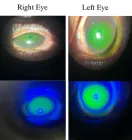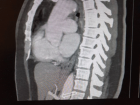Table of Contents
Cystic fibrosis and congenital adrenal hyperplasia: A rare occurrence with diagnostic dilemmas, similarities and contradictions
Published on: 20th October, 2020
OCLC Number/Unique Identifier: 8686101406
Cystic fibrosis (CF) is a hereditary syndrome composed of exocrine gland dysfunction involving multiple systems which if untreated may result in chronic respiratory infections, pancreatic enzyme deficiency and failure to thrive. The association between CF and other inherited diseases or congenital anomalies is rare. We describe a rare case of CF with concomitant congenital adrenal hyperplasia (CAH). 21- Hydroxylase deficiency accounts for most CAH cases. Varity in clinical phenotypes depends on the amount of enzymatic activity which in turn depends on different combination of gene mutations. The genes of CAH and CF are located in different locations. The chance of these diseases coexisting in our patient would be a rare combination. However, such a case will be more frequent in our population than others because of consanguineous marriage and common ancestors. There are diagnostic difficulties, similarities and contradictions between two diseases and they are pointed out.
Short-term responses to high-dose inhaled corticosteroid treatment in patients with chronic obstructive pulmonary disease with a fractional nitric oxide concentration over 35 parts per billion: A single-centre pre–post study
Published on: 6th October, 2020
OCLC Number/Unique Identifier: 8686101260
Introduction: There is currently no strategy for identifying chronic obstructive pulmonary disease (COPD) patients whose pulmonary function could benefit from inhaled corticosteroids. We investigated whether a 28-day regime of inhaled corticosteroids improved pulmonary function test results among COPD patients with a fractional exhaled nitric oxide concentration > 35 parts per billion.
Methods: This single-centre one-arm pre–post trial included COPD patients with a fractional exhaled nitric oxide concentration > 35 parts per billion treated at our institution from September 2018 to August 2019. Patients were administered budesonide (200 μg, 8 puffs daily) for 28 days. The primary outcome measure was the difference between the forced expiratory volume in 1 s (FEV1) at baseline and after 28 days of inhaled corticosteroid treatment. Secondary outcomes included differences in COPD Assessment Test scores, %FEV1, and that between the percent forced vital capacity (%FVC) at baseline and after 28 days of treatment.
Results: Twenty patients completed the 28-day inhaled corticosteroid regime. The mean difference in FEV1 between day 1 and day 28 was 340 mL (95% confidence interval: −100 to 770 mL; p = 0.122). The mean differences in secondary outcomes were: %FVC, −0.16% (95% confidence interval [CI]: −2.84 to 2.53%; p = 0.905); %FEV1, 1.63% (95%CI: −4.56 to 7.81%; p = 0.589); COPD Assessment Test score, −2.50 (95%CI: −5.72 to 0.72; p = 0.121).
Conclusion: The 28-day course of inhaled corticosteroids yielded no significant difference in FEV1 for COPD patients with a fractional exhaled nitric oxide concentration > 35 parts per billion.
Trial registration: University Hospital Medical Information Network Center, UMIN000034005. Registered 3 September 2018.
https://upload.umin.ac.jp/cgi-open-bin/ctr/ctr_view.cgi?recptno=R000038557
A mild form of Familial Mediterranean Fever associated with a polymorphisms C.NT 1588,-69G>
Published on: 11th August, 2020
OCLC Number/Unique Identifier: 8648993484
Familial Mediterranean fever (FMF) is an autosomal recessive autoinflammatory disease caused by mutation(s) in the Mediterranean fever (MEFV, pyrinmarenostrin) gene [1,2]. FMF is characterized by recurrent fever crises combined with serosal, synovial, or cutaneous inflammation and, in some individuals, by the eventual development, in the long-term, of systemic amyloidosis [3,4]. FMF mainly affects peoples living along eastern Mediterranean Sea (Turks, Sephardic Jews, Armenians) and it is not a rare disease in other Mediterranean areas such as Greeks, Italians and Iranians [4,6]. Until now, more than 304 sequence variants have been recorded [6]. In Italy M694V, V726A, M680I, M694I and E148Q are the most frequent FMF-associated mutations [7].
Here, we describe a recent case of mild FMF, characterized by all the clinical manifestations indicative of FMF described in the literature, according to Tei-Hashomer criteria [4] and by the analysis of MEFV gene, characterized by polymorphism c1588-69G>A. This is in agreement with previous our observations in a wider sample collected in the years. We are training to define the relations among gene mutations and clinical forms of FMF.
Immune system and quality of life following aerobic exercise versus resistance exercise training among Alzheimer’s
Published on: 30th April, 2020
OCLC Number/Unique Identifier: 8588736449
Background: Globally, Alzheimer’s disease (AD) affects millions of elderly individuals are affected with AD who suffer from decline in cognitive ability. However, immune system dysfunction has a role in AD pathogenesis. However, pharmacological therapeutic intervention for caring of ADis not available. Therefore there is a need to develop novel therapeutic modalities for AD individual care.
Objective: The objective of the this trial was to detect immune system and quality of life (QOL) response following aerobic versus resisted exercise training among AD subjects.
Methods: Fifty older with AD disease the range of age ranged was 61 to 73 years enrolled in the current study. However, smoking, liver, chest, renal, metabolic and cardiac dysfunction considered as exclusion criteria. Participants were randomly enrolled into group (A) who applied aerobic exercise intervention, while group (B) applied resisted exercise intervention for period of six months.
Results: The SF-36 which measure QOL along with in the immunological parameters (CD3 count, CD4 count, CD8 count and CD4/CD8 ratio) showed significant improvement following aerobic and resisted exercise. However, comparing between both groups showed significant differences with greater significant improvement in all measured parameters following aerobic exercise training (p < 0.05).
Conclusion: Aerobic exercise is the most appropriate exercise to improve immune system and quality of life among elderly Alzheimer’s.
Retrosternal goiter mimicking asthma: A diagnostic challenge
Published on: 10th January, 2020
OCLC Number/Unique Identifier: 8529515341
Asthma is a chronic respiratory disease characterized by chronic airway inflammation. Common manifestations of asthma include wheezing, chest tightness, cough, shortness of breath. Diagnosis of asthma requires clinical documentation of respiratory symptoms, exacerbation of symptoms following exposure to triggers, as well as demonstration of expiratory airflow obstruction. Wheeze is a continuous sound, lasting longer than 0.25 s that is produced by oscillation of opposing airway walls [1,2]. Wheezing, although a typical symptom of asthma, can also be caused by other diseases. Apart from asthma, wheezing can be due to extra-thoracic upper airway obstruction, intrathoracic upper airway obstruction, lower airway obstruction.
Benign multimodal goiter is a common disease, that rarely causes upper airway obstruction. Retrosternal goiter should be taken into account the differential diagnosis of upper airway obstruction [3]. The respiratory symptoms of a retrosternal goiter may be masked for years due to the slow growth of the goiter. Patients commonly complain of respiratory symptoms if tracheal diameter is narrowed more than 50% from the normal size. Respiratory symptoms may be suddenly precipitated by spontaneous or traumatically induced bleeding into the substernal goiter, as well as by tracheal infections [4]. Clinical management of this condition is really challenging. Diagnosis is also not straightforward, as clinical suspicion is needed. There are cases of retrosternal goiter mimicking asthma that remain undiagnosed for many years. Retrosternal goiter should be taken into account in the differential diagnosis of patients diagnosed as suffering from asthma, and presenting no improvement despite medical therapy. In addition, it should be taken into account that sudden gland enlargement due to hormonal changes might lead to life threatening upper airway obstruction with clinical picture similar to bronchial asthma attack [5]. In a recent very interesting case report, the authors present a case of a pregnant woman in the second trimester who presented with an acute airway obstruction due to the enlargement of a retrosternal goiter [3].
Goiters are the more common masses of the superior mediastinum [6,7]. Commonly, retrosternal goiter is due to the extension in the thorax of a cervical goiter. However, rarely, it may represent primary disease due to the growth of ectopic thyroid tissue. In addition, retrosternal goiter may develop in patient submitted to thyroidectomy due to cervical multinodular goiter [8]. Although retrosternal goiters are commonly asymptomatic, symptoms may include dyspnea, stridor, hoarseness, dysphagia, superior vena cava syndrome, transient ischemic attacks, cerebral edema, Horner’s syndrome, and thyrotoxicosis [4]. Diagnosis could be verified by neck and chest radiography, thorax CT and MRI. Chest radiography commonly shows a widened mediastinum with a superior mediastinal mass causing compression of the trachea as well as deviation of the trachea to the right. Mediastinal computed tomography reveals a mass that is extension of the thyroid gland. The presence of respiratory symptoms in a patient with retrosternal goiter is an indication for surgery. The majority of retrosternal goiters can be approached through a cervical approach [9,10].

If you are already a member of our network and need to keep track of any developments regarding a question you have already submitted, click "take me to my Query."

















































































































































